AIRBUS Bundle
How Does Airbus Dominate the Skies?
In the high-stakes world of aerospace, understanding the AIRBUS SWOT Analysis is critical. Airbus's success story is a masterclass in strategic sales and marketing, from its early days challenging Boeing to its current position as a global leader. Discover how Airbus crafts its commercial strategy and navigates the competitive landscape to secure its place in the market.
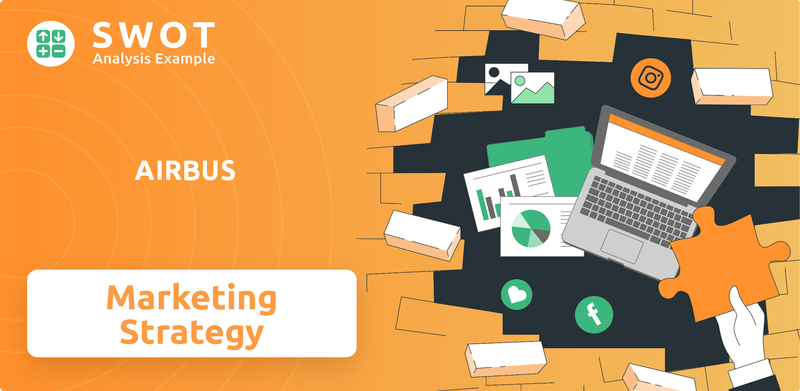
This exploration delves into the core of Airbus's
How Does AIRBUS Reach Its Customers?
The core of the Airbus sales strategy relies on a direct sales model. This approach allows for tailored solutions and strong, lasting relationships with clients. This is crucial in the aerospace industry, where deals are complex and high-value.
Airbus's customer base is diverse, including commercial airlines, government entities, and private jet operators. The company segments the commercial jetliner market to meet specific operational needs, such as those of low-cost carriers versus full-service airlines. This targeted approach helps them to maximize their sales potential.
Airbus also generates significant revenue through its services and support division. This includes maintenance, training, spare parts, and digital services. The company's 'Flight Hour Services' contracts have seen a doubling of their customer base since the COVID-19 pandemic, indicating a strategic shift towards comprehensive service solutions.
Airbus primarily uses a direct sales model to engage with its customers. This allows for personalized service and the building of long-term relationships. This is especially important in the aerospace industry due to the high value of the transactions.
The services and support division provides a significant revenue stream. This includes maintenance, training, and spare parts. The 'Flight Hour Services' contracts have seen substantial growth, indicating a shift towards comprehensive service solutions.
Airbus forms strategic collaborations with tech giants for digital transformation and sustainable aviation solutions. These partnerships are essential for driving innovation and meeting the evolving needs of the aviation industry.
Airbus's order book was valued at €629 billion ($692 billion) at the end of 2024, up 13.5% from 2023. This strong order book, with 8,658 commercial aircraft in backlog, demonstrates the success of its direct sales and relationship management approach.
Airbus's Airbus sales strategy focuses on direct sales, service offerings, and strategic partnerships. The direct sales model allows for customization and relationship building. Services and support, including digital solutions, are growing rapidly.
- Direct Sales: Direct engagement with airlines and other customers.
- Services and Support: Maintenance, training, and spare parts.
- Strategic Partnerships: Collaborations for technology and sustainability.
- Digital Services: Skywise platform for data-driven solutions.
- Market Segmentation: Targeting different airline business models.
AIRBUS SWOT Analysis
- Complete SWOT Breakdown
- Fully Customizable
- Editable in Excel & Word
- Professional Formatting
- Investor-Ready Format
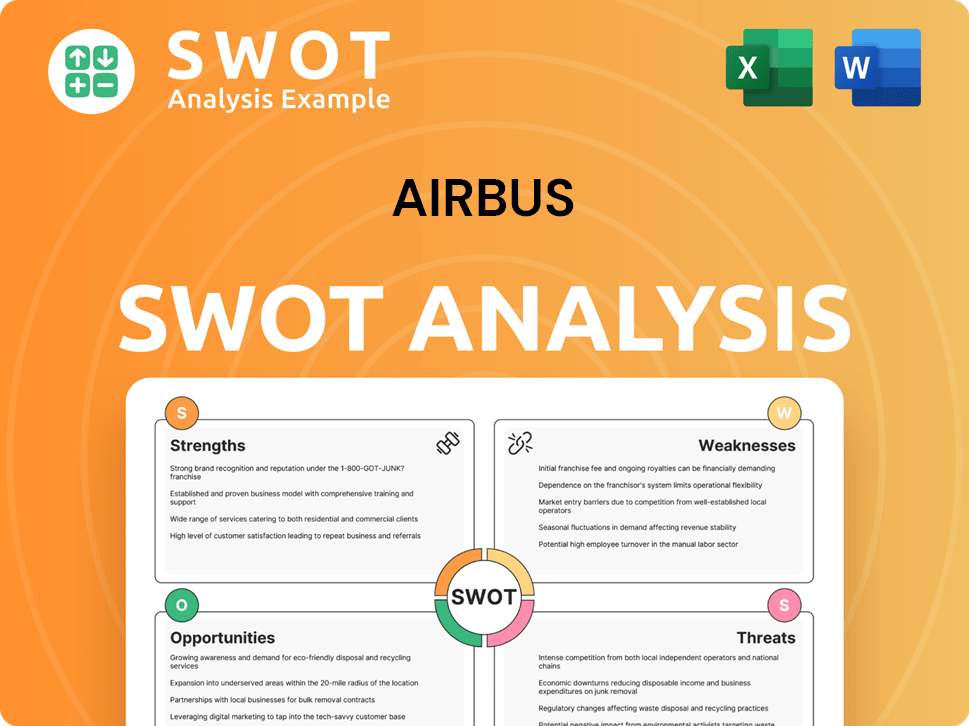
What Marketing Tactics Does AIRBUS Use?
The marketing tactics employed by Airbus are designed to boost awareness, generate leads, and drive sales within the aviation sector. Their approach combines digital and traditional strategies to effectively reach potential customers and maintain a strong market presence. This comprehensive strategy is crucial for competing in the global aviation market.
Digital transformation is a cornerstone of Airbus's marketing efforts. They leverage data-driven solutions and platforms like Skywise to optimize operations and enhance customer experiences. This focus allows for more personalized and efficient communication with stakeholders, attracting global talent and driving innovation.
Airbus's Revenue Streams & Business Model of AIRBUS reveals the importance of a robust marketing strategy in supporting its financial goals. By understanding the market and adapting to changing trends, Airbus aims to maintain its position as a leader in the aviation industry.
Airbus utilizes its website, social media, and targeted online advertising to create engaging content. This content educates potential customers about its aircraft and brand values. Multi-touchpoint videos and display ads are also used across news websites.
Participation in major air shows and industry events is vital for showcasing the latest aircraft. These events allow Airbus to interact with potential customers and demonstrate its technological leadership. This includes showcasing new models and innovations.
Airbus collaborates with airlines for co-marketing efforts. An example is the 'Better Non-Stop' campaign with Air India for the A350 aircraft. This campaign utilized train panels, taxis, digital screens, and airport advertising in London, enhancing brand visibility.
Customer segmentation is based on airline business models and passenger experience. This allows for tailored offerings and marketing messages. Personalization, understanding unique needs, and offering customized solutions are key.
Airbus has implemented the 'Crowdcraft' program, a crowdsourcing platform for technical challenges. This leads to cost and time savings. Simplifying complex technical information for broader audience engagement is also a focus.
While specific platforms are not detailed, the use of Skywise suggests a strong reliance on internal data analytics. Empathy mapping and persona development are also used to drive successful marketing initiatives, ensuring effective communication.
Airbus's Airbus marketing strategy focuses on a blend of digital and traditional methods. This approach is essential for reaching a global audience in the competitive aviation market. Their Airbus sales strategy is supported by data-driven customer segmentation and personalized marketing efforts.
- Digital Platforms: Utilizing websites, social media, and targeted advertising.
- Industry Events: Participating in air shows to showcase new models and technologies.
- Partnerships: Collaborating with airlines for co-marketing campaigns.
- Data Analysis: Employing data analytics to understand customer needs and preferences.
- Innovation: Using crowdsourcing platforms to solve technical challenges.
AIRBUS PESTLE Analysis
- Covers All 6 PESTLE Categories
- No Research Needed – Save Hours of Work
- Built by Experts, Trusted by Consultants
- Instant Download, Ready to Use
- 100% Editable, Fully Customizable
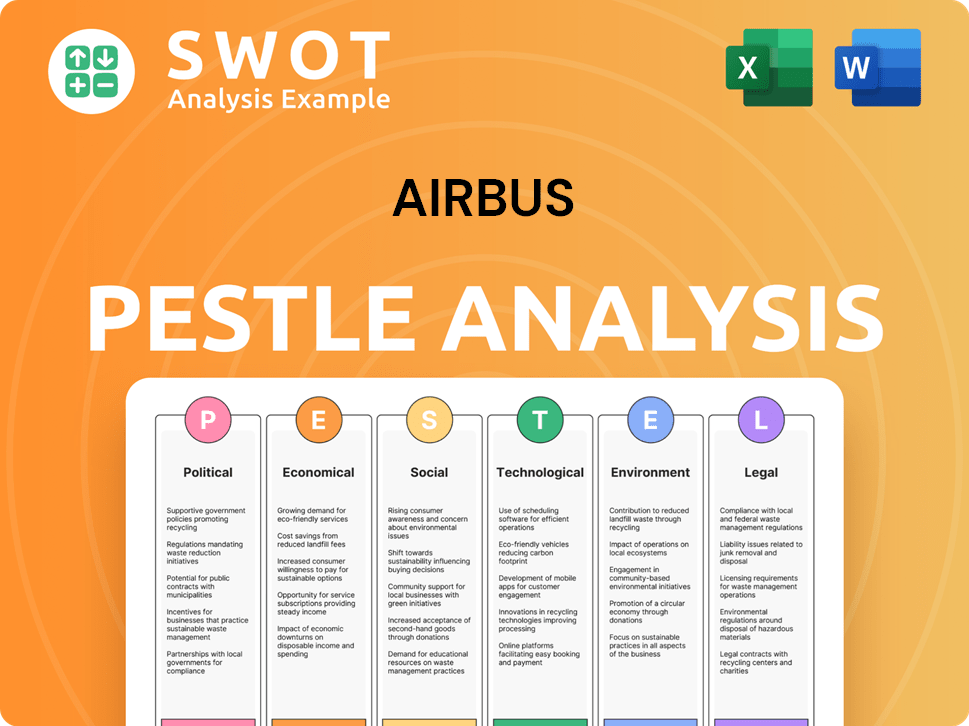
How Is AIRBUS Positioned in the Market?
Airbus strategically positions itself as a global leader in the aerospace industry, focusing on innovation, technology, and environmental responsibility. Their brand message centers around pushing aviation boundaries, providing safe aircraft, and contributing to sustainable air travel. This is evident in their emphasis on fuel efficiency, passenger comfort, and advanced in-flight entertainment systems. The company's Target Market of AIRBUS includes commercial airlines, government entities, private jet operators, and freight companies, tailoring offerings to meet specific needs.
Visually, the brand identity uses a deep blue, associated with quality and security. The logo, with its curved lines, represents the unification of its founding companies and its global reach. The tone of voice is authoritative and forward-looking, highlighting technical prowess and reliability. Airbus's approach involves continuous investment in research and development (R&D) and a focus on sustainable aviation solutions to adapt to market demands.
Airbus's brand perception is strong, with its financial value increasing. The brand's value increased by 12% to USD $16.1 billion in a 2024 brand valuation study. The brand also maintains a Brand Strength Index score of 83.73 and an AAA- brand strength grade, reflecting its strong brand equity and global recognition, with over 90% awareness among the traveling public.
Airbus focuses on a direct sales approach, working closely with airlines and other customers to understand their needs. This includes offering customized solutions and building strong relationships. The company's sales strategy emphasizes technological advancements and fuel efficiency to attract customers.
The marketing strategy includes participation in major air shows, digital marketing campaigns, and public relations. Airbus uses these channels to showcase its latest aircraft models and technological innovations. They also highlight their commitment to sustainability and environmental responsibility.
Airbus's commercial strategy involves offering a diverse product portfolio to meet different customer needs. This includes the A320 family for short to medium-haul flights and the A350 for long-haul routes. They also focus on providing comprehensive customer support and services.
Airbus conducts thorough market analysis to identify trends and opportunities in the aviation industry. This includes assessing the demand for new aircraft and understanding the competitive landscape. They use this data to inform their sales and marketing strategies.
Airbus competes with Boeing and Embraer, among others, in the global aerospace market. Airbus differentiates itself through its focus on innovation, fuel efficiency, and customer service. Strategic partnerships and investments in R&D help maintain its competitive edge.
- Innovation and Technology Leadership
- Focus on Fuel Efficiency and Sustainability
- Strong Customer Relationships and Support
- Strategic Partnerships and Market Expansion
AIRBUS Business Model Canvas
- Complete 9-Block Business Model Canvas
- Effortlessly Communicate Your Business Strategy
- Investor-Ready BMC Format
- 100% Editable and Customizable
- Clear and Structured Layout
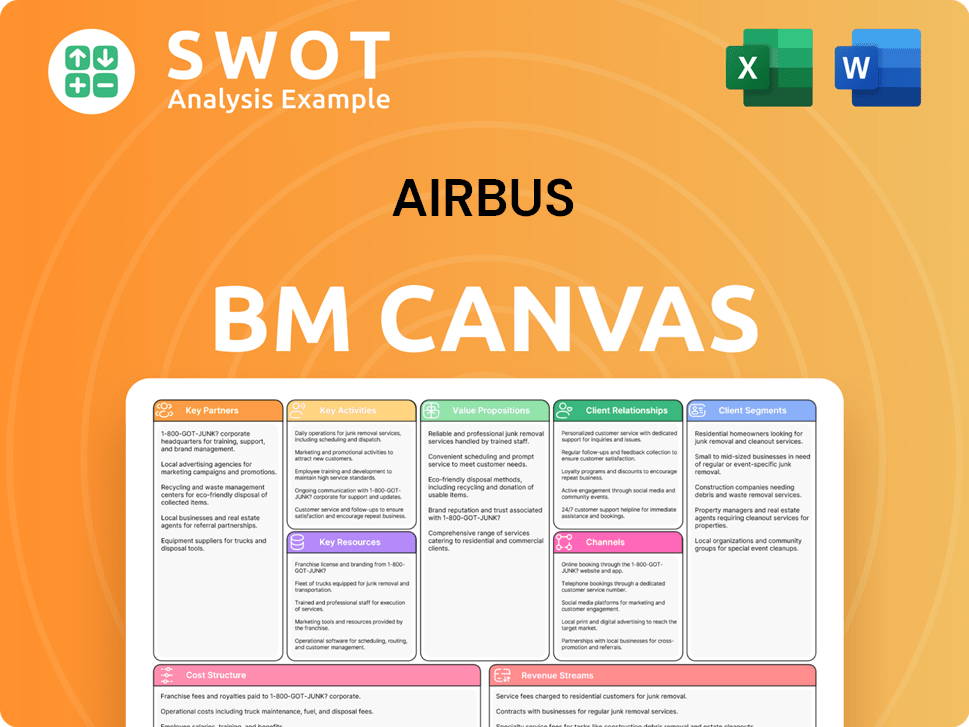
What Are AIRBUS’s Most Notable Campaigns?
Airbus employs strategic campaigns to boost sales and reinforce its brand. These initiatives often spotlight aircraft features, promote innovations, and uphold brand values, playing a crucial role in their Growth Strategy of AIRBUS. A key aspect of their Airbus sales strategy involves launching new aircraft or enhancing existing models, with a strong focus on passenger comfort and operational efficiency.
A significant campaign type centers around new aircraft launches and the enhancement of current models, with an emphasis on passenger comfort and operational efficiency. For example, the marketing of the A350 highlighted wider seats and fuel efficiency, key differentiators for airlines. This approach effectively communicated the value proposition through research, direct experiences, and compelling storytelling. This is part of their comprehensive Airbus marketing strategy.
Airbus's campaigns also highlight technological advancements and sustainability. A recent example is Air India's 'Better Non-Stop' campaign in London, launched in August 2024, to showcase the upgraded experience on the new A350. This campaign utilized various channels, including train panels, black taxis, digital screens, and online advertising, to highlight the enhanced onboard experience and position the A350 as a new standard.
Airbus frequently launches campaigns to promote new aircraft models or enhancements to existing ones. These campaigns often focus on passenger comfort, operational efficiency, and the latest technological advancements. The successful marketing of the A350, emphasizing wider seats and fuel efficiency, is a prime example of how Airbus communicates its value proposition effectively.
Collaboration with airlines is a key element of Airbus's marketing strategy. The 'Better Non-Stop' campaign with Air India, launched in August 2024, is a recent example. This campaign utilized various channels, including train panels, digital screens, and online advertising, to showcase the enhanced onboard experience of the A350, targeting business and leisure travelers.
Airbus campaigns also highlight technological advancements and its commitment to sustainability. The 'Innovation Storytellers Show' is an example of communicating Airbus's innovation marketing and digital transformation. While not a traditional sales campaign, it builds brand credibility and showcases the company's forward-thinking approach. These efforts support the overall Airbus commercial strategy.
Airbus has also engaged in crisis management and rebranding efforts to improve its corporate image. Following the restructuring of EADS into Airbus Group, the company rebranded its military units to Airbus Defense and Space and Airbus Helicopters. The continuous evolution of the Airbus logo reflects its desire to project a modern and trustworthy image.
AIRBUS Porter's Five Forces Analysis
- Covers All 5 Competitive Forces in Detail
- Structured for Consultants, Students, and Founders
- 100% Editable in Microsoft Word & Excel
- Instant Digital Download – Use Immediately
- Compatible with Mac & PC – Fully Unlocked
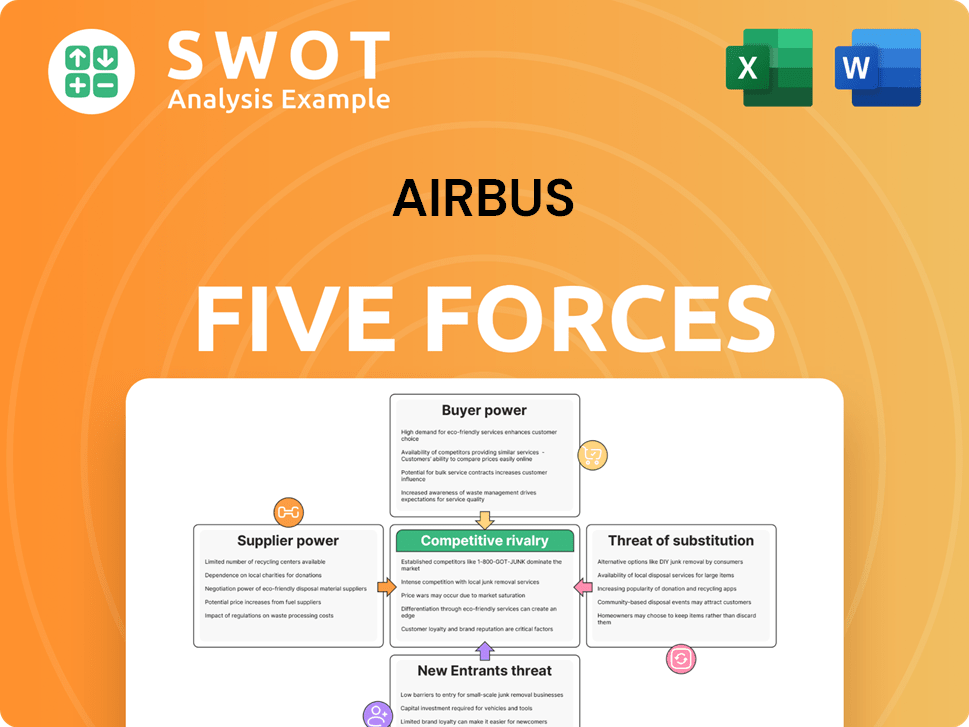
Related Blogs
- What are Mission Vision & Core Values of AIRBUS Company?
- What is Competitive Landscape of AIRBUS Company?
- What is Growth Strategy and Future Prospects of AIRBUS Company?
- How Does AIRBUS Company Work?
- What is Brief History of AIRBUS Company?
- Who Owns AIRBUS Company?
- What is Customer Demographics and Target Market of AIRBUS Company?
Disclaimer
All information, articles, and product details provided on this website are for general informational and educational purposes only. We do not claim any ownership over, nor do we intend to infringe upon, any trademarks, copyrights, logos, brand names, or other intellectual property mentioned or depicted on this site. Such intellectual property remains the property of its respective owners, and any references here are made solely for identification or informational purposes, without implying any affiliation, endorsement, or partnership.
We make no representations or warranties, express or implied, regarding the accuracy, completeness, or suitability of any content or products presented. Nothing on this website should be construed as legal, tax, investment, financial, medical, or other professional advice. In addition, no part of this site—including articles or product references—constitutes a solicitation, recommendation, endorsement, advertisement, or offer to buy or sell any securities, franchises, or other financial instruments, particularly in jurisdictions where such activity would be unlawful.
All content is of a general nature and may not address the specific circumstances of any individual or entity. It is not a substitute for professional advice or services. Any actions you take based on the information provided here are strictly at your own risk. You accept full responsibility for any decisions or outcomes arising from your use of this website and agree to release us from any liability in connection with your use of, or reliance upon, the content or products found herein.